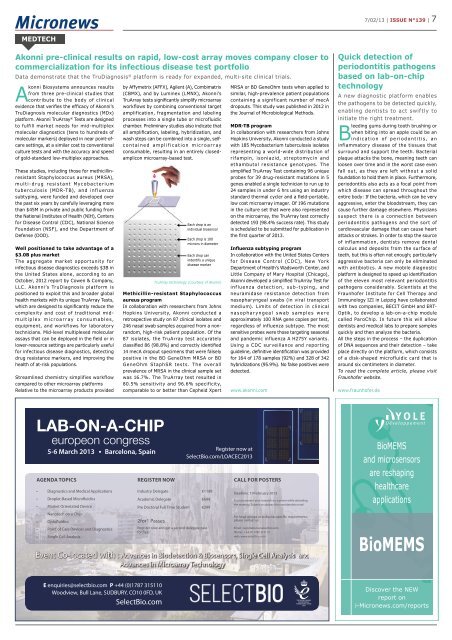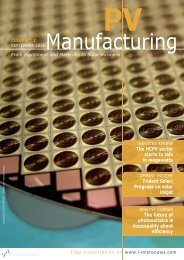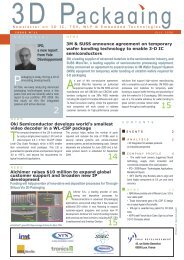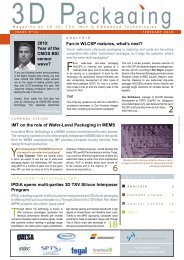issue n°139 - I-Micronews
issue n°139 - I-Micronews
issue n°139 - I-Micronews
You also want an ePaper? Increase the reach of your titles
YUMPU automatically turns print PDFs into web optimized ePapers that Google loves.
7/02/13 | ISSUE N°139 | 7<br />
MEDTECH<br />
Akonni pre-clinical results on rapid, low-cost array moves company closer to<br />
commercialization for its infectious disease test portfolio<br />
Data demonstrate that the TruDiagnosis ® platform is ready for expanded, multi-site clinical trials.<br />
Akonni Biosystems announces results<br />
from three pre-clinical studies that<br />
contribute to the body of clinical<br />
evidence that verifies the efficacy of Akonni’s<br />
TruDiagnosis molecular diagnostics (MDx)<br />
platform. Akonni TruArray ® Tests are designed<br />
to fulfill market needs for mid-multiplex<br />
molecular diagnostics (tens to hundreds of<br />
molecular markers) deployed in near point-ofcare<br />
settings, at a similar cost to conventional<br />
culture tests and with the accuracy and speed<br />
of gold-standard low-multiplex approaches.<br />
These studies, including those for methicillinresistant<br />
Staphylococcus aureus (MRSA),<br />
multi-drug resistant Mycobacterium<br />
tuberculosis (MDR-TB), and influenza<br />
subtyping, were funded and developed over<br />
the past six years by carefully leveraging more<br />
than $45M in private and public funding from<br />
the National Institutes of Health (NIH), Centers<br />
for Disease Control (CDC), National Science<br />
Foundation (NSF), and the Department of<br />
Defense (DOD).<br />
Well positioned to take advantage of a<br />
$3.0B plus market<br />
The aggregate market opportunity for<br />
infectious disease diagnostics exceeds $3B in<br />
the United States alone, according to an<br />
October, 2012 report by Cowen & Company,<br />
LLC. Akonni’s TruDiagnosis platform is<br />
positioned to exploit this and broader global<br />
health markets with its unique TruArray Tests,<br />
which are designed to significantly reduce the<br />
complexity and cost of traditional midmultiplex<br />
microarray consumables,<br />
equipment, and workflows for laboratory<br />
technicians. Mid-level multiplexed molecular<br />
assays that can be deployed in the field or in<br />
lower-resource settings are particularly useful<br />
for infectious disease diagnostics, detecting<br />
drug resistance markers, and improving the<br />
health of at-risk populations.<br />
Streamlined chemistry simplifies workflow<br />
compared to other microarray platforms<br />
Relative to the microarray products provided<br />
by Affymetrix (AFFX), Agilent (A), Combimatrix<br />
(CBMX), and by Luminex (LMNX), Akonni’s<br />
TruArray tests significantly simplify microarray<br />
workflows by combining conventional target<br />
amplification, fragmentation and labeling<br />
processes into a single tube or microfluidic<br />
chamber. Preliminary studies also indicate that<br />
all amplification, labeling, hybridization, and<br />
wash steps can be combined into a single, selfcontained<br />
amplification microarray<br />
consumable, resulting in an entirely closedamplicon<br />
microarray-based test.<br />
Each drop is an<br />
individual biosensor<br />
Each drop is 100<br />
microns in diameter<br />
Each drop can<br />
indentify a unique<br />
disease marker<br />
TruArray technology (Courtesy of Akonni)<br />
Methicillin-resistant Staphylococcus<br />
aureus program<br />
In collaboration with researchers from Johns<br />
Hopkins University, Akonni conducted a<br />
retrospective study on 87 clinical isolates and<br />
246 nasal swab samples acquired from a nonrandom,<br />
high-risk patient population. Of the<br />
87 isolates, the TruArray test accurately<br />
classified 86 (98.8%) and correctly identified<br />
14 mecA dropout specimens that were falsely<br />
positive in the BD GeneOhm MRSA or BD<br />
GeneOhm StaphSR tests. The overall<br />
prevalence of MRSA in the clinical sample set<br />
was 16.7%. The TruArray test resulted in<br />
80.5% sensitivity and 96.6% specificity,<br />
comparable to or better than Cepheid Xpert<br />
MRSA or BD GeneOhm tests when applied to<br />
similar, high-prevalence patient populations<br />
containing a significant number of mecA<br />
dropouts. This study was published in 2012 in<br />
the Journal of Microbiological Methods.<br />
MDR-TB program<br />
In collaboration with researchers from Johns<br />
Hopkins University, Akonni conducted a study<br />
with 185 Mycobacterium tuberculosis isolates<br />
representing a world-wide distribution of<br />
rifampin, isoniazid, streptomycin and<br />
ethambutol resistance genotypes. The<br />
simplified TruArray Test containing 96 unique<br />
probes for 39 drug-resistant mutations in 5<br />
genes enabled a single technician to run up to<br />
24 samples in under 6 hrs using an industry<br />
standard thermal cycler and a field-portable,<br />
low cost microarray imager. Of 196 mutations<br />
in the culture set that were also represented<br />
on the microarray, the TruArray test correctly<br />
detected 193 (98.4% success rate). This study<br />
is scheduled to be submitted for publication in<br />
the first quarter of 2013.<br />
Influenza subtyping program<br />
In collaboration with the United States Centers<br />
for Disease Control (CDC), New York<br />
Department of Health’s Wadsworth Center, and<br />
Little Company of Mary Hospital (Chicago),<br />
Akonni developed a simplified TruArray Test for<br />
influenza detection, sub-typing, and<br />
neuramidase resistance detection from<br />
nasopharyngeal swabs (in viral transport<br />
medium). Limits of detection in clinical<br />
nasopharyngeal swab samples were<br />
approximately 100 RNA gene copies per test,<br />
regardless of influenza subtype. The most<br />
sensitive probes were those targeting seasonal<br />
and pandemic influenza A H275Y variants.<br />
Using a CDC surveillance and reporting<br />
guideline, definitive identification was provided<br />
for 164 of 178 samples (92%) and 328 of 342<br />
hybridizations (95.9%). No false positives were<br />
detected.<br />
www.akonni.com<br />
Quick detection of<br />
periodontitis pathogens<br />
based on lab-on-chip<br />
technology<br />
A new diagnostic platform enables<br />
the pathogens to be detected quickly,<br />
enabling dentists to act swiftly to<br />
initiate the right treatment.<br />
Bleeding gums during tooth brushing or<br />
when biting into an apple could be an<br />
indication of periodontitis, an<br />
inflammatory disease of the t<strong>issue</strong>s that<br />
surround and support the teeth. Bacterial<br />
plaque attacks the bone, meaning teeth can<br />
loosen over time and in the worst case even<br />
fall out, as they are left without a solid<br />
foundation to hold them in place. Furthermore,<br />
periodontitis also acts as a focal point from<br />
which disease can spread throughout the<br />
entire body: If the bacteria, which can be very<br />
aggressive, enter the bloodstream, they can<br />
cause further damage elsewhere. Physicians<br />
suspect there is a connection between<br />
periodontitis pathogens and the sort of<br />
cardiovascular damage that can cause heart<br />
attacks or strokes. In order to stop the source<br />
of inflammation, dentists remove dental<br />
calculus and deposits from the surface of<br />
teeth, but this is often not enough; particularly<br />
aggressive bacteria can only be eliminated<br />
with antibiotics. A new mobile diagnostic<br />
platform is designed to speed up identification<br />
of the eleven most relevant periodontitis<br />
pathogens considerably. Scientists at the<br />
Fraunhofer Institute for Cell Therapy and<br />
Immunology IZI in Leipzig have collaborated<br />
with two companies, BECIT GmbH and ERT-<br />
Optik, to develop a lab-on-a-chip module<br />
called ParoChip. In future this will allow<br />
dentists and medical labs to prepare samples<br />
quickly and then analyze the bacteria.<br />
All the steps in the process – the duplication<br />
of DNA sequences and their detection – take<br />
place directly on the platform, which consists<br />
of a disk-shaped microfluidic card that is<br />
around six centimeters in diameter.<br />
To read the complete article, please visit<br />
Fraunhofer website.<br />
www.fraunhofer.de<br />
<br />
<br />
5-6 March 2013 Barcelona, Spain<br />
AGENDA TOPICS<br />
Diagnostics and Medical Applications<br />
Droplet-Based Microfluidics<br />
Market Orientated Device<br />
Nanotech on a Chip<br />
Optofluidics<br />
Point of Care Devices and Diagnostics<br />
Single Cell Analysis<br />
REGISTER NOW<br />
Industry Delegate €1199<br />
Academic Delegate €699<br />
Pre Doctoral Full Time Student €299<br />
2for1 Passes<br />
Register now and get a second delegate pass<br />
for free!<br />
Register now at<br />
SelectBio.com/LOACEC2013<br />
CALL FOR POSTERS<br />
Deadline: 19 February 2013<br />
You can present your research on a poster while attending<br />
the meeting. Submit an abstract for consideration now!<br />
For large groups or to discuss specific requirements,<br />
please contact us:<br />
Email: registrations@selectbio.com<br />
Phone: +44 (0) 1787 315115<br />
web: www.selectbio.com<br />
Event Co-located with : Advances in Biodetection & Biosensors, Single Cell Analysis and<br />
Advances in Microarray Technology<br />
BioMEMS<br />
and microsensors<br />
are reshaping<br />
healthcare<br />
applications<br />
BioMEMS<br />
E enquiries@selectbio.com P +44 (0)1787 315110<br />
Woodview, Bull Lane, SUDBURY, CO10 0FD, UK<br />
SelectBio.com<br />
Discover the NEW<br />
report on<br />
i-<strong>Micronews</strong>.com/reports
















